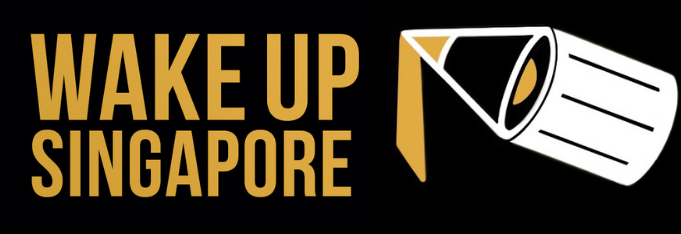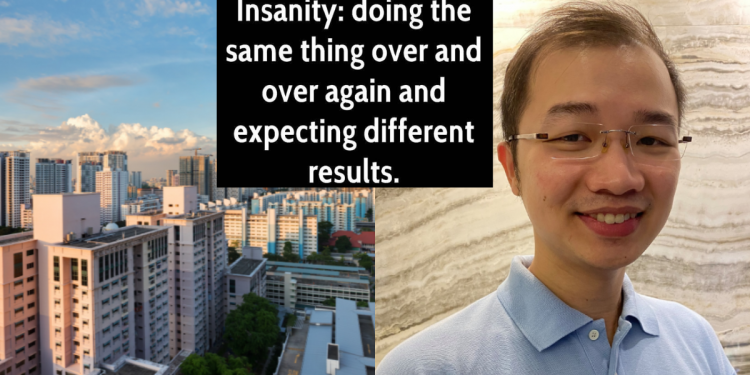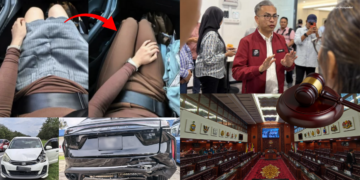Last year, Workers’ Party MP Louis Chua made the case for reducing the BTO eligibility age to 28 for singles.
On 6 February 2023, in another well-researched speech on housing policy as a whole, he urged the Government to take urgent and decisive steps to increase the availability of public housing and ensure that the housing needs of all Singaporeans are met.
On public housing motion, MP Louis Chua urged the Government to urgently execute on boosting the supply of housing to address the supply shortfall in the market today.
— The Workers' Party (@wpsg) February 6, 2023
The full transcript of his speech is reproduced below.
Introduction
Mr Speaker I would like to first declare my interest as an equity research analyst in a financial institution, covering the real estate industry.
Mr Speaker, “Insanity is doing the same thing over and over and expecting different results.” This saying is usually attributed to Albert Einstein, but one might argue also appears to be the current approach to the multitude of housing related issues we are seeing in Singapore today.
HDB is prepared to launch up to 100,000 flats in total from 2021 to 2025, if needed. HDB will continue to monitor housing demand and make adjustments, where necessary.
These statements was first made known in December 2021, after a broad suite of property cooling measures were introduced. We had another round of cooling measures in September 2022, with a particular focus on the HDB market. Yet following multiple Parliamentary Questions and speeches by myself and other fellow MPs, iterations of statements quoting the “up to 100,000 flats” from 2021 to 2025 figure remain.
I say that there is a clear need today for not just 100,000 flats in total from 2021 to 2025 but certainly more, and it is clearly necessary to make adjustments urgently. The objective of my speech today is thus a very simple one: for the Government to urgently execute on the policy to boost the supply of housing to address the shortfall in the market today.
Manifestations of a demand-supply imbalance
It is not difficult to see manifestations of the severe demand-supply imbalance in our housing market today.
In the latest 4th quarter 2022 housing data release, HDB resale prices continue to remain firm, rising 2.3% from the last quarter, with the increase higher than the 2.1% Quarter-On-Quarter (QoQ)increase initially estimated for the quarter. This was in spite of the cooling measures introduced in September 2022. For the full year 2022, HDB resale prices saw another year of double-digit price increases at 10.4% compared to a year ago. In the last three years, HDB resale prices rose by a whopping 31%!
Private residential prices similarly rose in spite of rising interest rates, though the extent of increase is ironically nowhere near that of the public housing market, with 2022 price increases of 8.6%, while in the last three years, prices were up by 22.8%. To put simply, resale HDB prices are rising far more rapidly compared to private residential prices. Importantly, there appears to be some signs of moderation in the private residential market, with prices up just 0.4% QoQ versus 3.8% a quarter ago.
The residential rental market is, for lack of a better word, in an even scarier situation. Private residential rents rose by 7.4% in just the most recent quarter alone, with rents up 30% in one year and 42% over the last three years! While the HDB does not publish a rental index, a comparison of median rentals across HDB towns paints a similar uncomfortable picture. Just a few days ago, Shin Min reported that a 74-year old HDB unit at Seng Poh Road was rented out at $6,200 a month. For 4-room HDB flats, median rents have risen by 22-50% in the last one year alone, with median rents up 29-68% in the last three years. And these are just a comparison of median rents, and to paraphrase what one of my residents at an earlier Meet-The-People Session shared with me when I quoted median rents in the market, you try to go on PropertyGuru, see whether you can find such low rents!
It is not hard to imagine how the rental market got so out of hand. Private residential vacancy rates are hovering near historical lows, at 5.5% as of the 4th quarter of 2022. For the HDB market, in response to my Parliamentary Question in October last year, the MND shared that over the past 5 years, the annual average number of unoccupied HDB units ranged from about 1,400 to 3,900. These units make up a mere 0.1% to 0.4% of completed flats.
Why HDB supply is insufficient
While multiple rounds of cooling measures in the past have typically focused on the demand-side of the home purchasing equation, fundamentally, I believe the shortage in supply is a key contributing factor causing the imbalances we see in the market today.
I acknowledge that compared to 2021, housing supply is set to increase by about 35% over 2022 and 2023, with about 23,000 BTO flats to be launched per year. Moreover, the HDB stated that it is prepared to launch up to 100,000 flats in total from 2021 to 2025, if needed, subject to prevailing demand. These numbers, however, need to be put in context.
Even if the HDB decides to launch the whole 100,000 flats in total from 2021 to 2025, this implies that BTO supply falls 20% to about 18,400 flats in 2024 and 2025. Moreover, while the average of 20,000 BTO flats between 2021 to 2025 is an increase compared to average of 17,000 flats between 2016-2020, this is still 13% below the average of 23,000 flats in 2011 to 2015, during the time when Mr Khaw Boon Wan was MND Minister and sought to address the backlog in HDB flats.
We have already seen BTO application rates climb steadily over the past decade to new highs. For 3-room and larger flats, this increased from 2.8x in 2012 to 6.1x in 2021 and 5.5x in 2022. Including 2-room flexi flats and on an overall basis, BTO application rates have climbed from 2.8x in 2012 to 5.6x in 2021 and 5.1x in 2022.
What is of greater concern is that despite the supposed ramp up in supply with 35% more units last year, overall application rates have remained stubbornly high at 5.1x in 2022, compared to an average of just over 3x in the decade prior, suggesting that the level of demand-supply imbalance remains a critical concern.
Private residential supply similarly tight; though private sector initiatives supportive
The issue of supply shortages is not unique to just the public residential sector but similarly applies to the private residential market as well, given the similar approach taken by the Government.
Again, I note that in percentage terms, the Government has increased the supply of private housing, including ECs, on the Confirmed List of the Government Land Sales programme by 75%, from around 3,600 units in 2021 to around 6,300 units in 2022. In the first half 2023 GLS programme, the number of units has also increased by about 17% Half-on-Half (HoH) to about 4,100 units.
We must however put these numbers into context. Last year saw the lowest annual primary sales volumes across private housing and EC units in the last fourteen years. But there were about 8,600 units sold. More than 36% of the number of units made available in new supply in 2022. If we consider the last ten year average primary sales volumes of about 12,000 units, then essentially last year’s new supply is just about half of average annual sales volumes.
It is no wonder that the level of unsold inventory in the private residential market is hovering near historical low levels today. And as I have shared earlier, private residential vacancy rates are hovering near historical lows, so it is not as if we are looking at ‘ghost towns’ being built. If and even if, there truly are excesses, whether in the short run or medium run, these can be repurposed into public rental flats which my honourable friend Jamus will elaborate further on.
Fortunately, or unfortunately, the private sector has its way of adding to residential supply through en-bloc and redevelopment schemes, which partially mitigates the supply situation. A cursory look at the new launches for 2023 would suggest that a significant number of them are derived not from the GLS but from en-bloc and redevelopments concluded over the last few years.
Strong local demand drivers
What then have been the key drivers of residential demand? In response to my PQ in October, the MND shared that demand for housing has been broad-based. On this point, I fully agree with the Government’s assessment of demand.
More households are forming as the echo-boomer generation – those who are in their 30s today – are getting married, especially with the easing of COVID-19 measures. We also see societal trends shifting to smaller households, as young couples, singles, as well as adult children choose to buy their own homes instead of living with their parents.
Indeed, I have observed that the growth in resident households has over the past decade consistently outpaced that of the resident population. To put into context once again the number BTO flats launched, the number of citizen marriages was
cumulatively about 230,000 over the last ten years up to 2021. However, the number of HDB BTO flats launched was only about 192,000 units in the same period. Yes, there could be a minority of citizens who can purchase private residential housing as the first home, but even ignoring demand from other groups of Singaporeans, the number of flats is insufficient to meet even the demands of our newly-weds!
The shrinking of overall average household sizes also does not appear to be letting up, at 3.15 as of 2021, the lowest recorded figure since 1990 when it was over 4.2. The MND too noted in a PQ response in November 2022, that over the past 20 years, the average household size among resident households living in HDB flats shrank from 3.57 to 3.09. For the near future, the MND expects housing demand to be robust due to strong household formation and societal trends toward smaller households.
My question then is, if it is already a known fact to the Government that the demand for housing is broad-based, and it is unlikely that societal trends are going to go into reverse anytime soon, shouldn’t we take more proactive steps to address demand from Singaporeans, rather than try to curb demand?
Net immigration to add further strain on housing demand
Moreover, I believe net immigration into Singapore could add further strain on local housing demand. In the latest labour market report for the third quarter 2022, the MOM noted that the labour market maintained its growth momentum in the quarter, as total employment continued to expand robustly, led by non-residents at 71,100 compared to residents at 4,800.
We are seeing high occupancy rates at dormitories as the number of Work Permit Holders in the Construction, Marine and Process (CMP) sectors is currently at more than 10% higher than pre-COVID levels. Two weeks ago, the Straits Times reported that record-high HDB rents and difficulties in securing accommodation are driving Malaysians working in Singapore to live in Johor Bahru and commute to Singapore daily for work instead.
Should the non-resident labour force continue to grow, this could continue to add further strain to our already strained housing market situation.
More can be done, beyond “100,000 between 2021 to 2025”
Can more be done? I certainly think so.
In October last year, I asked if additional sites can be activated to increase the number of HDB BTO flat launches beyond the current plan to launch up to 100,000 flats in total from 2021 to 2025, should demand exceed current projections; and if not, what are the constraints for not being able to do so.
Apart from reiterating existing plans to launch up to 100,000 flats between 2021 to 2025, I don’t think I got a response to my question.
However, if we look at the HDB BTO launches over the last ten years, approximately half of the sites used for public housing developments over the past 10 years were greenfield. In comparison to brownfield sites, and certainly so for sites which are already located within existing housing estates, there need not be as much land preparation works that need to be done.
Just last month, the honourable Mr Gan Thiam Poh even asked whether the open land between TPE and Fernvale Street will be used to build HDB BTO flats to meet the increased demand for public housing; and if so, when will the HDB flats be built there. I note that based on the URA’s gazetted Master Plan 2019, plot ratios for certain sites have even been determined at 2.1 and 3.5, with the road name Fernvale Crescent also decided! So, like Mr Gan, I too hope the MND will launch HDB flats at Fernvale Crescent soon.
I am comforted by PM Lee’s comments during the National Day Rally earlier this year, where he shared that and I quote, “We have done our studies and planning. We will have enough space for future generations. Our problem is not finding the space to build enough flats, nor keeping homes affordable for Singaporeans. We know how to do that.”
I thus sincerely hope the Government can take urgent and decisive steps to increase the availability of public housing and ensure that the housing needs of all Singaporeans are met. Allow me to conclude in Mandarin.
Conclusion
政府经常强调,无论过去,现在,还是未来,居者有其屋始终是新加坡的 主要住房战略。既然这是政府的立场,我认为政府可以有效实施这一战略 是理所当然的。
我知道,与 2021 年相比,2022 年和 2023 年每年约有两万三千套预购组屋 单位可供申购,这两年内的住房供应量会增加约 35%。此外,建屋局表示, 如有需要,计划在 2021 年至 2025 年间推出多达十万个单位,但必须视当 时的需求而定。然而,我们必须在正确的背景下看待这些数据。
即使建屋局决定在 2021 年至 2025 年间推出十万个单位,这仍意味着预购 组屋的供应量在 2024 年和 2025 年将下降 20%,这两年年均仅有约一万八 千四百个新单位。此外,2021 年至 2025 年间平均每年推出两万个预购组 屋单位。虽然这一数据较 2016 年至 2020 年间的年均一万七千个单位有所 增加,但仍比 2011 年至 2015 年间,当时许文远担任国家发展部部长积极 尝试解决当时的组屋需求问题时,年均推出约两万三千个新单位的预购组 屋单位数量低 13%。
过去几年里,我们可以看到预购组屋的申购率稳步攀升,不断创下新高。 更值得关注的是,尽管过去两年的住房供应量有所增加,申购率依旧徘徊 在五倍左右,处于过去十年平均水平的高端。这表明供需的失衡程度仍然 是一个棘手的问题。
我在去年九月在国会提出休会动议,呼吁政府采取紧迫果断的措施,增加 公共住房的供应量,解决目前供需不平衡的问题。
我国总理李显龙已经在 2022 年群众大会演讲说道,我们的问题不在于没 有足够的空间来建造组屋,也不在于我们没有能力让国人负担得起房子。 今天,我仍然希望政府能认真考虑我们的请求,人民的请求,通过确保公 共住房的充足供应,支持新加坡人实现拥有属于自己的家的愿望。
More from Wake Up Singapore
More from Wake Up Singapore:
Since you have made it to the end of the article, follow Wake Up Singapore on Telegram!





